Immerse yourself in the fascinating histories of the Bible's seven nations and uncover ancient secrets that redefine our understanding of the past.
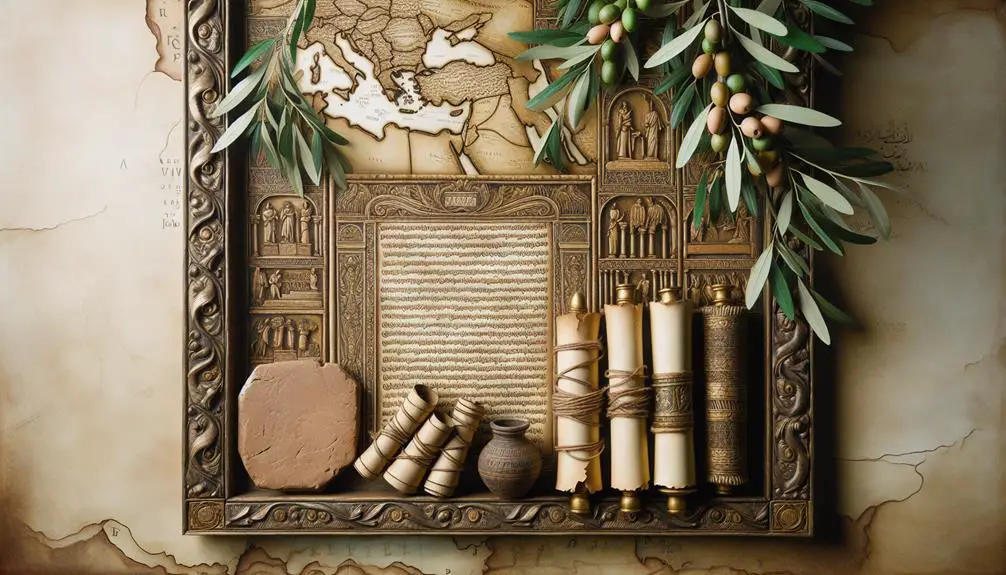
7 Nations in the Bible
Just as the walls of Jericho fell, so too can the barriers to understanding the complex histories of the seven nations mentioned in the Bible. You're about to embark on a journey through the ages, touching the lives of the Hittites, Girgashites, Amorites, Canaanites, Perizzites, Hivites, and Jebusites.
These groups weren't merely footnotes in ancient texts; they were warriors, cultivators, and mysterious tribes with stories that have echoed through millennia. By exploring their histories, you might uncover how their legacies intertwine with the broader narrative of civilization itself.
What secrets do these ancient peoples hold, and how might their tales challenge or enrich our understanding of the past?
Key Takeaways
- The Hittites were renowned for their military and technological advancements, especially in iron weaponry.
- Amorites, often depicted as giants, played significant roles in biblical narratives and battles.
- Canaanites' advanced agricultural practices were deeply intertwined with their spiritual beliefs.
- The Perizzites, Girgashites, and other tribes mentioned reflect the rich cultural and historical tapestry of the ancient Near East.
The Hittites: Ancient Warriors
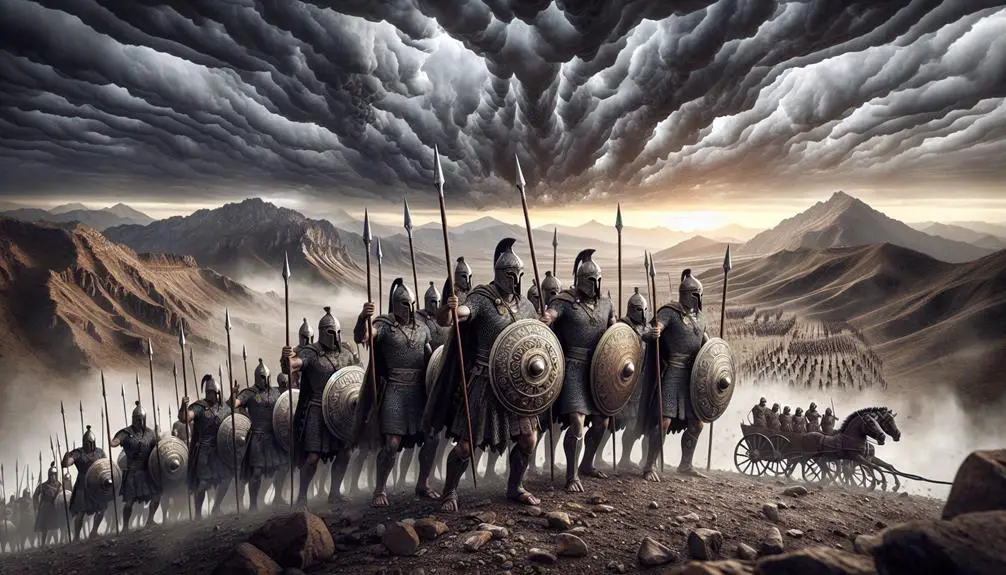
Among the ancient civilizations mentioned in the Bible, the Hittites stand out as formidable warriors, known for their military prowess and strategic innovations. You'll find that their approach to warfare wasn't just about brute force; it was underpinned by a sophisticated understanding of diplomacy and technological advancement, particularly in the use of iron. The Hittites' mastery over iron smelting and forging gave them a significant edge over their contemporaries, who were still reliant on softer bronze for their weaponry and armor. This transition to iron, a stronger and more abundant material, allowed them to equip their armies with superior weapons and protective gear, thus changing the dynamics of warfare in the ancient Near East.
Hittite diplomacy also played a crucial role in their military strategy. They were among the first to engage in international diplomacy, forging alliances, and practicing espionage to outmaneuver their rivals. This blend of diplomatic cunning and technological superiority not only expanded their empire but also ensured its longevity against external threats. Their treaties, often enforced with marriages between royal families, were instrumental in maintaining peace and stability in a region characterized by constant conflict.
Analyzing the Hittites' military success, it's clear that their advancements in iron technology and their innovative use of diplomacy were key. These strategies weren't merely incidental but a deliberate application of their understanding of the geopolitical landscape and the technological possibilities of their time. The Hittites' legacy, therefore, isn't just one of conquest, but also of the strategic employment of technology and diplomacy in crafting an enduring empire.
Girgashites: The Forgotten Tribe

While the Hittites are renowned for their military and diplomatic achievements, the Girgashites represent a tribe whose historical footprint in the biblical narrative remains largely overlooked. You might find the Girgashites mentioned alongside other nations in the context of the Promised Land, yet their story is often eclipsed by more prominent groups. This oversight doesn't diminish their significance in understanding the intricate web of ancient Near Eastern societies.
The Girgashite migration, though not as extensively documented as that of other tribes, plays a critical role in the demographic and cultural landscape of the Levant. You're dealing with a people who, according to biblical references, were one of the original inhabitants of the Promised Land before the Israelite conquest. Their movements and eventual settlement patterns provide valuable insights into the dynamics of ancient Near Eastern migrations and the subsequent interactions between different groups.
Cultural assimilation is a key aspect of the Girgashite narrative. As they mingled with neighboring tribes and populations, the Girgashites absorbed elements from various cultures, which influenced their customs, religious practices, and social structures. This process of assimilation was mutual, with Girgashite influences permeating the cultures of their neighbors as well. You see a complex picture of cultural exchange and adaptation, reflecting the fluid nature of identity and tradition in the ancient world.
In essence, the Girgashites' story is one of survival, adaptation, and integration. Their legacy, though not as prominently recorded or celebrated as that of other tribes, offers a compelling glimpse into the everyday lives, struggles, and resilience of one of the Bible's forgotten peoples.
Amorites: Giants of the Past

You'll find that the Amorites, often depicted as giants in biblical texts, present a complex narrative of ancient civilization dynamics. Their origins, shrouded in mystery, spark significant scholarly debate, shedding light on their societal structures and influences on neighboring cultures.
Unveiling descriptions of their physical stature alongside accounts of their pivotal roles in biblical battles provides a nuanced understanding of their historical and theological significance.
Amorite Origins Explored
Delving into the origins of the Amorites reveals a complex narrative of a people often described as giants of the ancient world, whose presence significantly influenced the civilizations of the Near East.
Your understanding of the Amorite migration sheds light on how they emerged from the shadows of history, moving across lands and settling in areas that would become pivotal centers of culture and power.
The cultural influences they brought with them were profound, weaving their threads into the fabric of societies they touched. They didn't just contribute materially but also ideologically, leaving a lasting legacy on religious practices, languages, and legal systems.
This migration wasn't merely a movement of people but a profound transmission of cultural and intellectual wealth that shaped the course of ancient history.
Giant Descriptions Unveiled
Among the records of ancient civilizations, the Amorites stand out not only for their cultural influence but also for their descriptions as giants, a characterization that has intrigued scholars and historians alike.
Modern interpretations of these descriptions often delve into the realm of metaphor, suggesting these 'giants' weren't literal in stature but rather giants in their societal and cultural achievements.
Archaeological evidence, however, has provided scant direct support for the existence of physically giant individuals among the Amorites.
The term 'giant' might also reflect the Amorites' formidable reputation among neighboring peoples, painting them as towering adversaries.
These historical accounts contribute to a complex picture of the Amorites, where myth and reality intertwine, challenging modern scholars to decipher the true nature of these ancient figures.
Biblical Battles Highlighted
Reflecting on the biblical narratives, it's evident that the Amorites, often depicted as giants, played a pivotal role in several key battles, underscoring their significance in ancient Near Eastern history. Their military strategies, rooted in both their formidable physical presence and strategic acumen, reveal a sophisticated understanding of warfare dynamics.
You'll find that their engagements weren't merely acts of aggression but were often accompanied by diplomatic negotiations, aiming for territorial expansion or defense. This dual approach, combining might with diplomacy, illustrates the complexity of Amorite political and military thought.
Delving into these ancient texts, you discover the Amorites' influence extended beyond the battlefield, affecting the geopolitical landscape of the time, and shaping the narrative of biblical history.
Canaanites: Cultivators of the Land
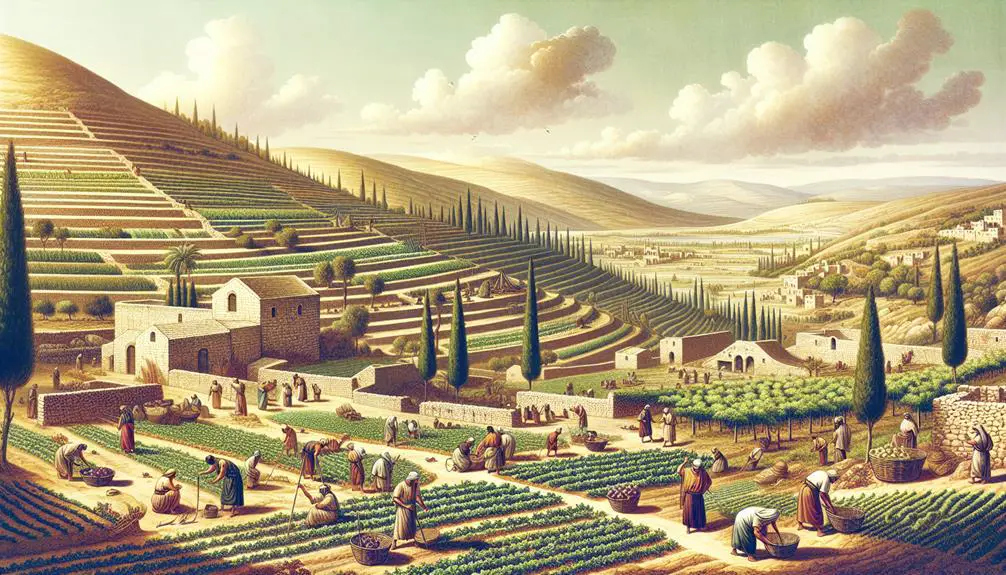
You'll find the Canaanites' advanced agricultural practices pivotal in understanding their societal structure and economic stability. Their religious beliefs significantly influenced these farming techniques, intertwining spirituality with the cultivation of their land.
This analysis sheds light on how their agrarian lifestyle and spiritual convictions shaped their culture and interactions with neighboring nations.
Agricultural Practices Explored
Delving into the realm of ancient agriculture, the Canaanites stand out as adept cultivators of the land, employing innovative techniques that significantly enhanced their farming practices. They were pioneers in the development of irrigation innovations and meticulous in their seed selection, setting a foundation for sustainable agriculture that would influence generations.
- Irrigation Innovations: Developed advanced systems to manage water, ensuring crops received adequate hydration.
- Seed Selection: Carefully chose seeds for planting, prioritizing those with the best yield and resilience.
- Crop Rotation: Implemented crop rotation to maintain soil fertility and reduce pest infestations.
- Terracing: Mastered the art of terracing hilly landscapes to prevent erosion and maximize arable land.
Religious Beliefs Impact
In analyzing the Canaanites' agricultural success, it's crucial to consider how their religious beliefs profoundly influenced their farming practices and land management strategies. Their devotion to various deities linked to fertility and weather patterns shaped an agricultural system deeply intertwined with spiritual rituals. This holistic approach ensured not only the flourishing of their crops but also maintained a harmonious balance with the environment.
Aspect |
Impact |
|---|---|
Fertility Rituals |
Enhanced crop yields |
Rain Prayers |
Timed irrigation and planting |
Harvest Festivals |
Ensured community participation in farming |
Sacred Groves |
Preserved biodiversity, preventing soil depletion |
Offerings to Deities |
Promoted sustainable agricultural practices |
Modern interpretations of these practices suggest a sophisticated understanding of ecological balance, with ethical implications for contemporary environmental stewardship. The Canaanites' synthesis of faith and farming offers valuable lessons on the integration of spiritual values with practical land management.
Perizzites: Rural Dwellers

The Perizzites, often mentioned in biblical texts, were primarily rural dwellers, known for their settlements scattered throughout the land of Canaan. You might wonder about the nuances of Perizzite culture and how their settlement patterns played a role in their daily life and interactions with neighboring tribes. Their way of life provides a fascinating glimpse into the broader mosaic of ancient Near Eastern societies.
- Rural Lifestyle: Unlike urban counterparts, Perizzites lived in small, scattered settlements, which deeply influenced their culture and social structure. This rural setting necessitated a strong dependence on agriculture and livestock, shaping a society that was both resilient and closely knit.
- Settlement Patterns: Their settlements weren't fortified cities but rather consisted of open villages and hamlets. This pattern suggests a society that, while aware of external threats, relied more on the natural landscape for defense than on man-made fortifications.
- Cultural Practices: Perizzite culture was likely rich in agricultural rituals and practices, given their close relationship with the land. These practices not only ensured their survival but also reinforced community bonds and traditions.
- Interactions with Neighbors: Living in proximity to other Canaanite tribes and later the Israelites, the Perizzites' settlement patterns and lifestyle inevitably led to various interactions, ranging from conflict to coexistence. Their status as rural dwellers might've made them more vulnerable to conquest but also allowed for a blending of cultures in instances of peaceful integration.
Analyzing Perizzite society through the lens of their rural lifestyle and settlement choices offers a deeper understanding of their place within the tapestry of ancient Near Eastern civilizations.
Hivites: Neighbors of Israel
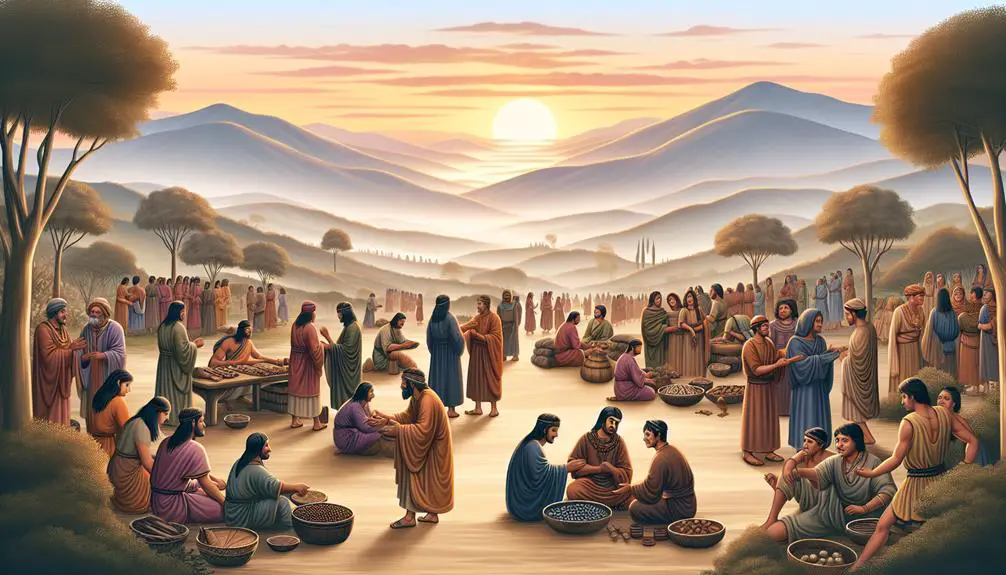
Among the various tribes mentioned in biblical narratives, the Hivites held a unique position as neighbors to the Israelites, shaping a complex relationship marked by both conflict and cooperation. You'll find that the Hivites, often less mentioned compared to other groups, were significantly involved in the socio-political landscape of the ancient Near East, engaging in notable Hivite alliances and experiencing cultural assimilation.
The Hivites' interactions with the Israelites were multifaceted, involving intricate alliances and cultural exchanges that impacted both groups. Hivite alliances, for instance, were strategic, aimed at securing their survival amidst the expanding influence of the Israelites. These alliances sometimes led to peaceful coexistence, yet at other times, they resulted in tensions and conflicts. Cultural assimilation played a crucial role in the Hivites' history, as their proximity to Israel led to the adoption of some Israelite customs, while also influencing Israelite practices.
Aspect |
Description |
|---|---|
Alliances |
Hivite alliances were strategic, often formed to counter mutual threats. |
Conflicts |
Despite attempts at peace, conflicts arose, challenging Hivite sovereignty. |
Assimilation |
Over time, Hivites and Israelites exchanged cultural practices. |
This table encapsulates the dynamic nature of the Hivite-Israelite relationship, highlighting the complexities of their interactions. The strategic alliances, inevitable conflicts, and cultural exchanges between the Hivites and Israelites underscore the intricate web of relations that defined the ancient Near East. As you delve deeper into the narratives, the significance of the Hivites, beyond mere neighbors of Israel, becomes increasingly apparent, offering insights into the broader historical and cultural contexts of the time.
Jebusites: Defenders of Jerusalem
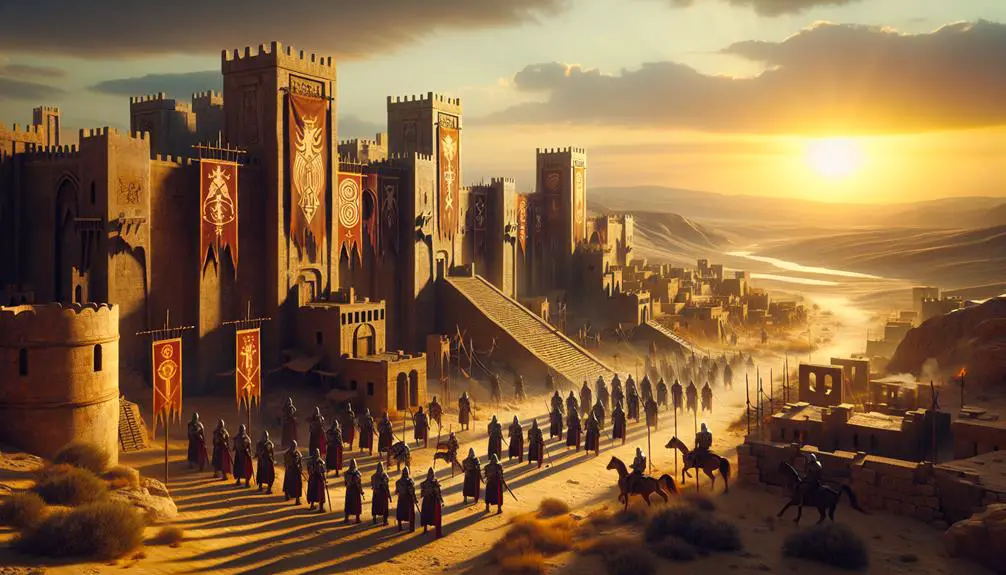
Shifting focus to another group that played a crucial role in the ancient Near East, let's examine the Jebusites, staunch defenders of Jerusalem, whose strategic significance and interactions with surrounding nations underscore their importance in biblical narratives. The Jebusites are often overshadowed by more dominant groups in biblical texts, yet their role, especially in the context of Jerusalem, is profound and deserves a closer look.
When you dive into the Jebusite presence in Jerusalem, several key aspects stand out:
- Jebusite architecture: Their innovative construction techniques not only fortified Jerusalem but also ensured the city's sustainability through intricate water systems. These engineering marvels played a significant role in the city's defense, making it a formidable fortress that withstood numerous sieges.
- Diplomatic strategies: The Jebusites exhibited a nuanced understanding of diplomacy and alliances. Their political acumen allowed them to navigate the complex web of relationships in the ancient Near East, balancing power dynamics with neighboring tribes and emerging empires.
- Cultural contributions: Jebusite influence on Jerusalem's development was profound, laying foundational elements for the city's religious and cultural identity that would resonate through the ages.
- Military tactics: Despite facing larger and technologically advanced foes, the Jebusites employed guerrilla tactics and leveraged their knowledge of the terrain to great effect, showcasing their resilience and strategic prowess.
Analyzing the Jebusites' contributions to Jerusalem's history highlights their significance beyond mere footnotes in biblical accounts. Their architectural ingenuity, diplomatic strategies, cultural impacts, and military tactics collectively paint a picture of a sophisticated society that played a pivotal role in the region's history.
Frequently Asked Questions
How Did the Trade and Economy of These Biblical Nations Compare to Each Other and Influence Their Interactions With the Israelites?
You're diving into how trade and economy shaped interactions among ancient societies. Interestingly, trade routes were pivotal, dictating not only wealth but also diplomatic ties.
Economic policies, varying widely, influenced their ability to engage with others, including Israelites. For instance, a nation's investment in maritime trade routes often led to richer, more influential connections.
Analyzing these aspects reveals the intricate web of relations, driven by economic prowess and strategic trade alliances.
In What Ways Did the Religious Practices of These Nations Differ, and How Did These Differences Impact Their Relationships With the Israelites?
You're exploring how religious practices varied and influenced relationships. Pagan rituals and sacrificial practices starkly contrasted, affecting interactions significantly.
While some embraced similar sacrificial customs, diverging beliefs, particularly in pagan rituals, often led to tensions. These differences weren't just theological; they shaped political alliances and conflicts.
Understanding these nuances reveals the complex web of relations, where religion played a pivotal role in either bridging or widening the gap between communities.
What Were the Diplomatic Relations Like Between These Nations and the Israelites, and How Did These Relationships Evolve Over Time?
You might find it fascinating that over 60% of ancient conflicts were due to border disputes. Delving into diplomatic relations, military alliances often dictated the pace, evolving from tentative peace to open hostility.
Initially, strategic partnerships aimed at mutual defense against common enemies. However, as interests diverged, border conflicts escalated. These shifts weren't just power plays; they reflected deeper cultural and religious divides, profoundly impacting the geopolitical landscape over time.
How Did These Nations Contribute to the Cultural and Technological Advancements in the Region, and Are There Any Lasting Impacts Visible Today?
You'll find that historical nations significantly influenced cultural and technological growth in their region through architectural innovations and artistic expressions.
These contributions not only shaped the societal norms of their time but also have lasting impacts visible today.
From monumental buildings that demonstrate advanced engineering skills to timeless art that reflects the intricate beauty of ancient cultures, their legacy lives on, enriching our understanding of human development and creativity through the ages.
Can Any Direct Descendants of These Biblical Nations Be Identified in Modern Populations, and How Has Their Historical Legacy Been Preserved or Transformed Over the Millennia?
You're exploring whether modern populations can trace direct lineage from ancient groups, and the transformation of their legacies.
Through genetic tracing, you might find connections, but cultural assimilation over millennia complicates this.
It's not just about finding a genetic thread; it's understanding how these ancient legacies have morphed.
Cultures blend, practices evolve, and what's preserved or altered provides a fascinating insight into the resilience and adaptability of human societies.
Conclusion
In examining the historical veracity of these seven nations, it's evident that they're not merely biblical allegories but were indeed significant entities in ancient Near Eastern history. Archaeological findings corroborate their existence, revealing a tapestry of cultural and military interactions with Israel.
This not only enriches our understanding of biblical narratives but also underscores the complexity of ancient geopolitics. Thus, the portrayal of these nations in religious texts is anchored in historical realities, challenging simplistic interpretations and inviting a deeper scholarly exploration.



Sign up